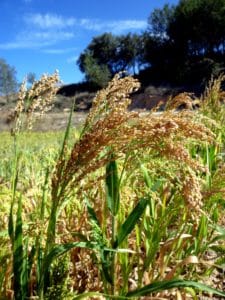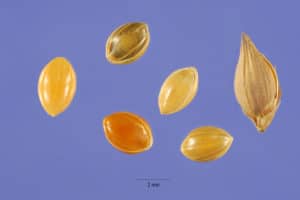 The modern world might benefit from a return to our ancient roots by expanding the cultivation of one of the first domesticated crops, broomcorn millet.
The modern world might benefit from a return to our ancient roots by expanding the cultivation of one of the first domesticated crops, broomcorn millet.
Foodies will appreciate that the crop, a staple in many semi-arid regions of Asia and Europe, is gluten-free and extremely nutritious, with higher levels of protein, several minerals, and antioxidants than most other cereals.
Farmers will appreciate that the drought-resistant plant has the highest water-use efficiency among all cereal crops, (i.e. the highest amount of grains produced with the same amount of water), a short life cycle (60–90 days), and a high harvest index.
And thanks to high-quality reference genomes recently published by two different scientific teams in China, breeders can now get to work mining the crop’s novel genetic traits.
First domesticated in Northern China around 10,000 years ago, broomcorn millet (Panicum miliaceum L.) — also known as common millet, proso millet, and hog millet — is mainly used for dryland farming where most other crops have failed, or as a summer rotation crop in temperate regions. Broomcorn millet breeding programs have benefitted little from genomic technologies, and have been conducted only on a small scale and in isolated regions of the world, but the crop’s hardiness in changing climate conditions has generated renewed interest.
“The genetic diversity of broomcorn millet varieties from different regions of the world remains a valuable but unexplored resource. Broomcorn millet could be used not only as a dryland crop but also as a crop in broader regions to support more water-efficient, sustainable agriculture,” wrote one of the scientific teams, led by Zhang Heng and Zhu Jiankang from Shanghai Center for Plant Stress Biology of Chinese Academy of Sciences, in Nature Communications.

Their study detailed their assembly of a high-quality reference genome of the allotetraploid, 36 chromosome, broomcorn millet, generated from SMRT Sequencing. Anchored to a high-density genetic map using Hi-C, the genome was assembled into 18 pseudo-chromosomes. A total of 305,520 transcripts were also de novo assembled from 241 Gb of mRNA-seq data.
Through this, they identified 220,000 genetic markers, 55,930 protein-coding genes and 339 microRNA genes.
Among the genes of particular interest were C4 photosynthesis genes. C4 plants like millet and its bioenergy crop relative switchgrass (Panicum virgatum), are more efficient in carbon fixation and in the use of water and nitrogen compared to their C3 relatives, such as rice, and much effort has been made in engineering C4 traits in C3 crops. But this requires a clear understanding of the molecular mechanism of C4 carbon fixation, and the Shanghai study authors are hopeful that their genome might provide some additional insights. Their analysis suggests that three different subtypes of C4 carbon fixation may coexist in broomcorn millet to help it better cope with fluctuating environments in the field.
“Utilizing more than one decarboxylation mechanism can help cope with dynamic and fluctuating environments in the field,” they wrote.
They also traced NAD-ME metabolic pathways and ubiquitin-like proteins, which are thought to play a role in the plant’s efficient utilization of nutrients under stress conditions.
The Phylogeny of Paniceae

In a separate Nature Communications study, Lai Jinsheng, Shi Junpeng, et al, from the Center for Crop Functional Genomics and Molecular Breeding of China Agricultural University, Beijing, reported their genome assembly through a combination of PacBio sequencing, BioNano, and Hi-C (in vivo) mapping.
They created 18 “super scaffolds” covering ~95.6% of the estimated 887.8 Mb genome, and annotated 63,671 protein-coding genes.
“Mining the genome of broomcorn millet uncovered the genes potentially involved in both biotic and abiotic stress resistance in broomcorn millet,” the authors wrote.
They identified 493 genes containing NB-ARC domain that may be involved in disease resistance, of which 20 genes (seven gene families) were specific in broomcorn millet, as well as 15 ABA or WDS (water-deficiency stress) responsive genes.
“Interestingly, four of these ABA genes were constitutively expressed with relatively high expressional level across all the samples we examined, even for the tissues or stages without salt or drought treatment,” the Beijing team added.
The team also delved into the evolution of the crop.
“By taking advantage of the high-quality assembly of broomcorn millet in this study, in combination with the newly published genomes of pearl millet and Dichanthelium oligosanthes, we were able to reconstruct the phylogeny in Paniceae,” the authors wrote.
Unlike maize, which experienced strong genome rearrangements and expansions after tetraploidization, broomcorn millet retained the majority of two copies of ancestral genes, kept the basal chromosome numbers (2n = 4 × = 36) and experienced relatively weak genome expansion, likely resulting from its more “recent” tetraploidization than other Panicaeae lines — within ~5.91 million years, the authors reported.
“The genome is not only beneficial for the genome-assisted breeding of broomcorn millet, but also an important resource for other Panicum species,” they wrote. “It will no doubt facilitate the comparative genomic research between Panicum and other crops.”